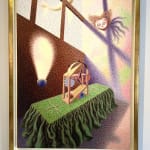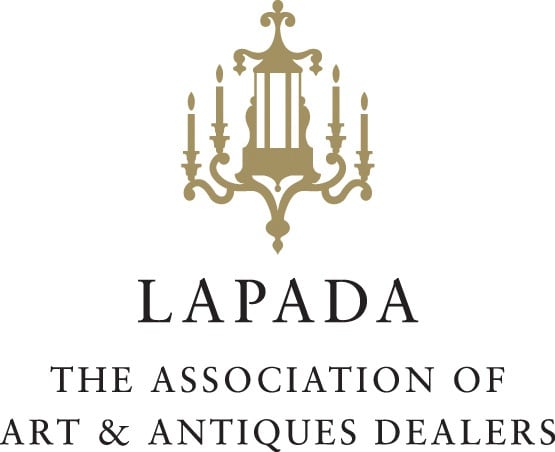-
Artworks
Henry Orlik b. 1947
TIMEAcrylic on canvasImage H. 70.5 cm. x W. 53 cm., H. 27 3/4 in. x W. 20 3/4 in.
Frame H. 77.5 cm. x W. 60 cm., H. 30 1/2 in. x W. 23 1/2 in.With artist's stamp versoWB1522Note: If you are interested in acquiring a work by Henry Orlik, please contact our team to discuss further options.Further images
In Time, Orlik presents a plethora of suggestive images suggesting the cosmological interpretation of time: of childhood, death and the passing of historical ages; what Bachelard calls ‘the catastrophe of time’ (Gaston Bachelard, The Poetics of Space, 2014, (first published 1958), p. 184).
Orlik gives us an enclosed room with high ceiling and large mullioned window through which we can see a white semi-circular form which is fish, bird, aeroplane and moon, creating earthly cosmic connections through time and space (the moon) and the elements (water, earth and air). Light from the window reflects on the wall, green, pink and yellow with suggestions of light leaking through a stained-glass window. This raises the suggestion of a church-like space and this image is heightened by the green-covered coffin, table or altar that dominates the room; the green covering of which has two crosses at either end and drapes down the side of the structure like tree roots reaching to the earth. On the coffin-table-altar sits a time machine, like an elaborate child’s toy, which encompasses a clock, the suggestion of a scales (weighted down on one end by a ball), and a child’s marble run; beneath the window a ball drops with a bright splash of light rising above it, like a time-bomb, falling planet, or comet crashing to the earth. On the wall a heart-shaped face appears, Cheshire Cat-like. Like a jester or joker’s head, its divided two-pointed tufty hair suggests the hat of a jester and the strange tendril-like shadows behind it reference the divided collar-ruff of a jester or clown. The body-less head is given a shadow stick for a body (from the shadow of the window mullion), and it becomes a jester’s marotte. The head has a mouth-less face, until the shadow beneath the chin becomes a huge clown smile and then the face transforms into Bozo the Clown with his two large tufts of hair sticking out from either side of his face. He is, perhaps, given a body and distorted arms by the shadow created by the window mullion and transom, or perhaps he becomes a figure crucified on a cross.
It is interesting to look at Orlik’s interest in clowns as symbols, and in the wider sense, their significance and connection to court jesters. In Poland, Stańczyk (c. 1480-1560) was a famous court jester at the time of the Renaissance. His popularity and his contribution as a symbol became of great importance to Polish culture in later centuries. His image reappeared significantly in the 19th century and remains well known to the present. He is remembered as a man of great intelligence, politically gifted with formidable insight into Poland's current and future situation and became a popular historical figure in Polish literature. Some writers treated him as a symbol of Poland's struggle for independence and one wonders if Orlik’s interest in jesters (and clowns) has a root in the stories of Poland’s historical plight for independence. In the play Wesele (The Wedding by StanisławWyspiańsi, 1901), one of the themes is the aspirations for national self-determination: the jester’s ghost visits the Journalist (a character in the play) and gives him his ‘caduceus’ (the jester’s marotte) and tells him to ‘stir the nation’ but not to ‘tarnish the sacred things, for sacred they must remain.’ Stańczyk became a symbol of patriotism and, significantly, sceptical political wisdom and perhaps the knowledge of his parents’ and their forebears’ hardships and his own subsequent political views, played a part in Orlik’s use of the clown as symbol.
Note: If you are interested in acquiring a work by Henry Orlik, please contact our team to discuss further options.12of 12
Join our mailing list
Be the first to hear about our upcoming exhibitions, events and news
* denotes required fields
We will process the personal data you have supplied to communicate with you in accordance with our Privacy Policy. You can unsubscribe or change your preferences at any time by clicking the link in our emails.














